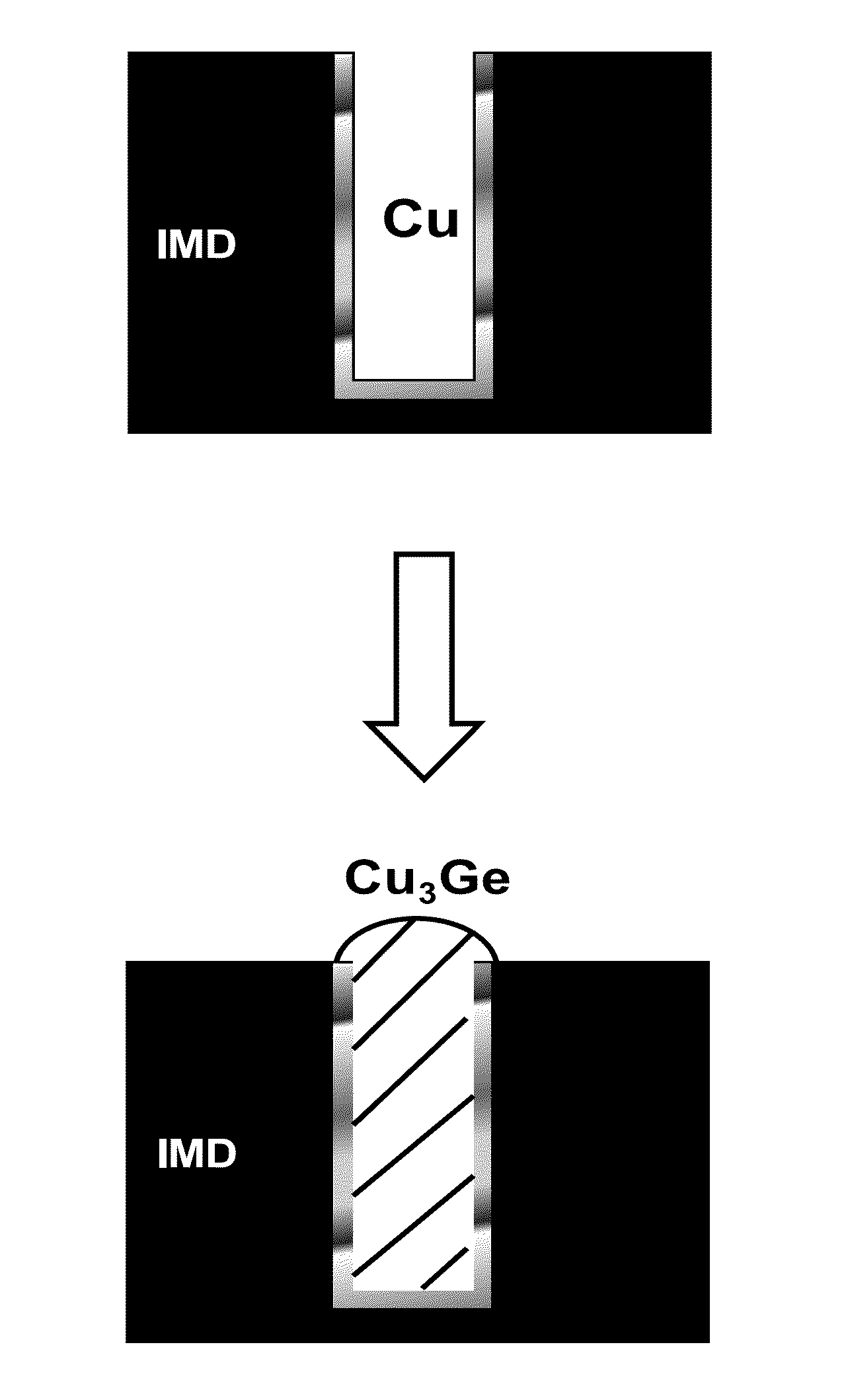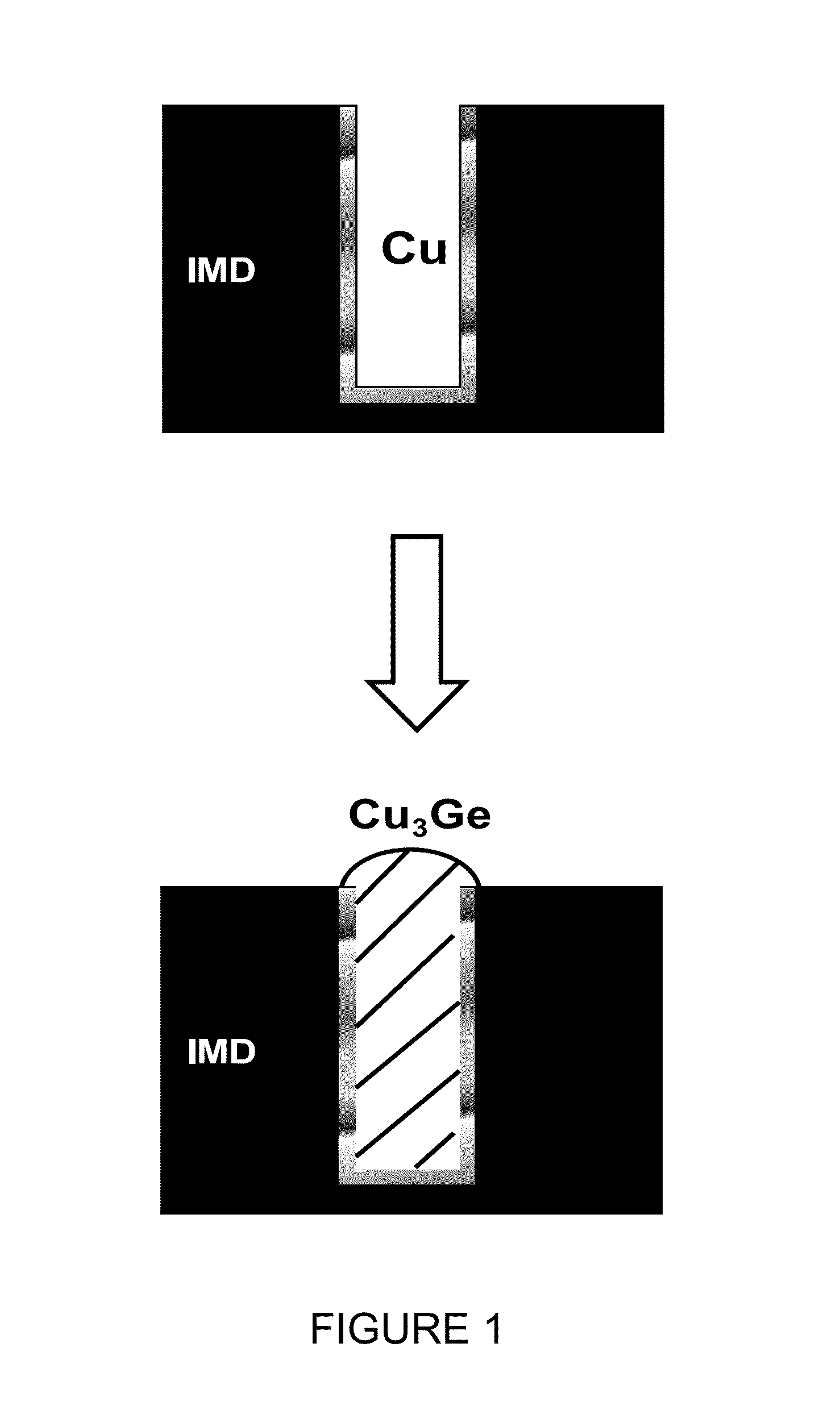Method for Manufacturing Germanide Interconnect Structures and Corresponding Interconnect Structures
a technology of interconnect structure and germanide, which is applied in the direction of solid-state devices, basic electric elements, electric devices, etc., can solve the problems that the known methods for obtaining the desired phase of metal germanides in dimensions below 30 nm are not suitable for interconnect fabrication of semiconductor devices, and achieve the effect of low resistivity
- Summary
- Abstract
- Description
- Claims
- Application Information
AI Technical Summary
Benefits of technology
Problems solved by technology
Method used
Image
Examples
first embodiment
[0091]The method of the first embodiment allows a good phase control in both narrow and wide structures as compared to a solid state reaction approach.
[0092]Moreover the method of the first embodiment is applicable to Cu3Ge formation in all types of structures (e.g. vias, dual damascene) by adjusting the soak time to the thickness of the Cu which needs to be converted to Cu3Ge for a fixed soak temperature and partial pressure of the germanium precursor.
[0093]Advantageously, the method of the first embodiment is suitable for both on-pitch and large pitch structures. In general the on-pitch structures are structures for which the width and the spacing dimensions are available (i.e. 30 / 30 nm trenches), while the off-pitch structures are structures for which the width is different than the spacing (i.e. 30 / 140 nm trenches).
[0094]Preferably, an additional CMP can be introduced after the copper germanide formation to remove the Cu3Ge overgrowth and improve the electrical results for the o...
second embodiment
[0096] the present disclosure relates to a method for forming a nickel germanide (NiGe) alloy in interconnect structures. In preferred embodiments the disclosure relates to a method for forming a Nickel germanide (NiGe) alloy in narrow interconnect structures characterized by a half pitch of 10 nm or smaller.
[0097]As previously described, with the down scaling of the interconnects technology, in the sub-20 nm line width region, the resistivity of interconnects is expected to dramatically increase. To a large extent this can be attributed to the increased grain boundary and surface scattering caused by the low electron mean free path of Cu (39 nm). Therefore, a suitable replacement for copper (Cu) offering a low resistivity in the region of interest needs to be found.
[0098]Nickel germanide (NiGe) has been found to be a suitable replacement for Copper (Cu) in reducing the interconnect resistivity. Although, nickel germanide (NiGe) may exhibit higher bulk resistivity compared to Copper...
third embodiment
[0123] the present disclosure relates to a method for forming a cobalt germanide alloy (CoGe2) in interconnect structures. More specifically the present disclosure relates to a method for forming a cobalt germanide alloy (CoGe2) alloy in narrow interconnect structures characterized by a half pitch of 30 nm or smaller, preferably characterized by a half pitch of 10 nm or smaller.
[0124]Cobalt germanide alloy (CoGe2) has been found to be a suitable replacement to copper (Cu) in reducing the interconnect resistivity. Although the bulk resistivity of cobalt germanide alloy (CoGe2) alloy is higher compared to copper (Cu), the resistivity increase of cobalt germanide alloy (CoGe2) is slower for interconnect dimensions of 30 nm or smaller.
[0125]The present disclosure provides a method for obtaining a low resistivity cobalt germanide alloy (CoGe2) alloy in contacts and interconnects by using a solid vapor reaction between cobalt (Co) and germane precursor, such as GeH4, referred to herein as...
PUM
 Login to View More
Login to View More Abstract
Description
Claims
Application Information
 Login to View More
Login to View More - R&D
- Intellectual Property
- Life Sciences
- Materials
- Tech Scout
- Unparalleled Data Quality
- Higher Quality Content
- 60% Fewer Hallucinations
Browse by: Latest US Patents, China's latest patents, Technical Efficacy Thesaurus, Application Domain, Technology Topic, Popular Technical Reports.
© 2025 PatSnap. All rights reserved.Legal|Privacy policy|Modern Slavery Act Transparency Statement|Sitemap|About US| Contact US: help@patsnap.com



